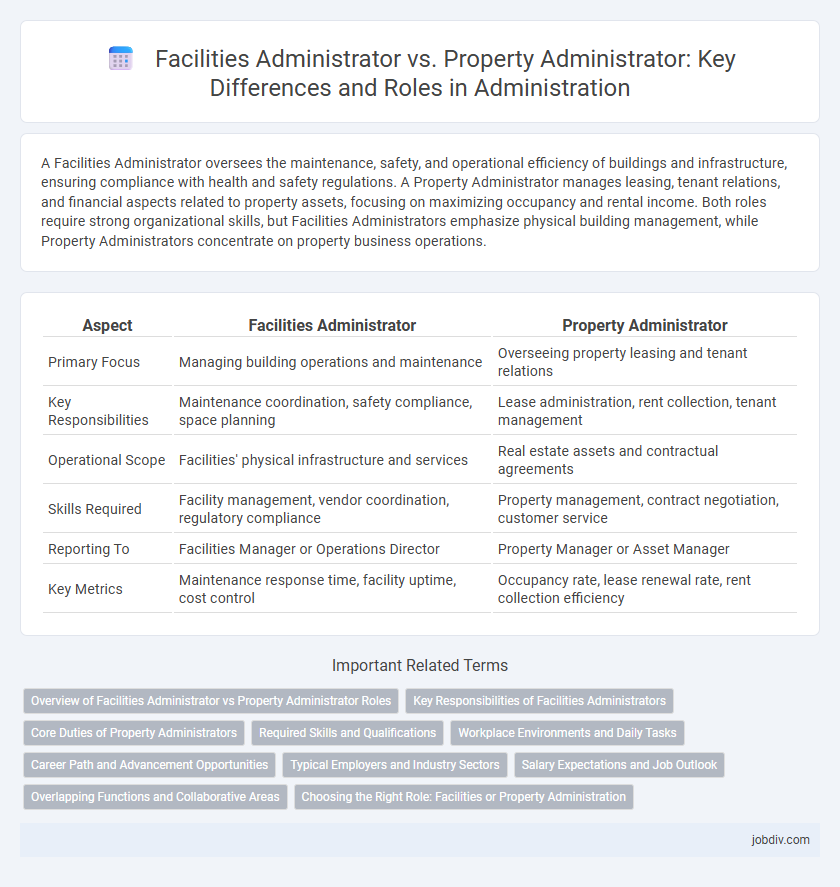A Facilities Administrator oversees the maintenance, safety, and operational efficiency of buildings and infrastructure, ensuring compliance with health and safety regulations. A Property Administrator manages leasing, tenant relations, and financial aspects related to property assets, focusing on maximizing occupancy and rental income. Both roles require strong organizational skills, but Facilities Administrators emphasize physical building management, while Property Administrators concentrate on property business operations.
Table of Comparison
| Aspect | Facilities Administrator | Property Administrator |
|---|---|---|
| Primary Focus | Managing building operations and maintenance | Overseeing property leasing and tenant relations |
| Key Responsibilities | Maintenance coordination, safety compliance, space planning | Lease administration, rent collection, tenant management |
| Operational Scope | Facilities' physical infrastructure and services | Real estate assets and contractual agreements |
| Skills Required | Facility management, vendor coordination, regulatory compliance | Property management, contract negotiation, customer service |
| Reporting To | Facilities Manager or Operations Director | Property Manager or Asset Manager |
| Key Metrics | Maintenance response time, facility uptime, cost control | Occupancy rate, lease renewal rate, rent collection efficiency |
Overview of Facilities Administrator vs Property Administrator Roles
Facilities Administrators oversee the operation, maintenance, and safety of physical buildings and infrastructure, ensuring compliance with health and safety regulations while managing vendor contracts and facility budgets. Property Administrators focus on managing rental properties, including tenant relations, lease agreements, rent collection, and property marketing to maximize occupancy and profitability. Both roles require strong organizational skills but differ in their emphasis on building maintenance versus tenant and lease management.
Key Responsibilities of Facilities Administrators
Facilities Administrators oversee the maintenance, safety, and operational efficiency of physical buildings, managing vendor contracts, coordinating repairs, and ensuring compliance with health and safety regulations. They optimize facility usage by implementing space management strategies and handling budget allocation for equipment and services. These responsibilities differ from Property Administrators, who primarily focus on lease management, tenant relations, and rent collection.
Core Duties of Property Administrators
Property Administrators primarily manage tenant relations, oversee lease agreements, and coordinate property maintenance to ensure operational efficiency and tenant satisfaction. They handle rent collection, enforce lease terms, and collaborate with contractors for repairs and improvements. Their role focuses on maximizing property value and compliance with local regulations, differentiating them from Facilities Administrators who concentrate more on building operations and internal support services.
Required Skills and Qualifications
Facilities Administrators require strong project management skills, knowledge of building systems, and expertise in health and safety regulations to ensure operational efficiency. Property Administrators need proficiency in lease management, financial acumen for budgeting and rent collection, and strong communication skills to handle tenant relations. Both roles demand organizational abilities and familiarity with relevant legal compliance but differ in technical focus and stakeholder interaction.
Workplace Environments and Daily Tasks
Facilities Administrators oversee the maintenance, safety, and functionality of workplace environments, ensuring optimal conditions for employee productivity. Property Administrators focus on managing leasing agreements, tenant relations, and property compliance within commercial or residential buildings. Daily tasks for Facilities Administrators include coordinating repairs and managing vendor contracts, while Property Administrators handle rent collection and regulatory documentation.
Career Path and Advancement Opportunities
Facilities Administrators often advance by specializing in building operations, safety compliance, or vendor management, leading to roles such as Facilities Manager or Operations Director. Property Administrators typically progress through tenant relations, lease management, and financial oversight, potentially moving into Property Manager or Real Estate Asset Manager positions. Both career paths offer opportunities in leadership, but Facilities Administrators focus more on physical asset management, while Property Administrators emphasize tenant and financial administration.
Typical Employers and Industry Sectors
Facilities Administrators commonly find employment within corporate headquarters, healthcare institutions, educational campuses, and manufacturing plants, specializing in managing building operations and maintenance. Property Administrators are typically employed by real estate firms, property management companies, housing associations, and commercial leasing agencies, focusing on tenant relations, lease administration, and property financials. Both roles play key parts across industries such as commercial real estate, healthcare, education, and industrial sectors, but their employer bases reflect distinct operational priorities and domain expertise.
Salary Expectations and Job Outlook
Facilities Administrators typically earn an average salary ranging from $50,000 to $70,000 annually, influenced by the size and industry of the organization, while Property Administrators often command slightly higher wages between $55,000 and $75,000 due to their direct involvement in real estate management. Job outlook for Facilities Administrators is stable with moderate growth expected as businesses continue to prioritize efficient operations and workplace safety. Property Administrators face a robust demand driven by expanding real estate markets and increasing regulatory complexities, leading to promising career opportunities.
Overlapping Functions and Collaborative Areas
Facilities Administrators and Property Administrators share overlapping functions such as managing maintenance schedules, coordinating vendor services, and ensuring compliance with safety regulations. Both roles collaborate closely on space allocation, budgeting for repairs, and handling tenant or occupant requests to optimize the utilization and upkeep of buildings. Effective communication between these administrators enhances operational efficiency and supports seamless facility management.
Choosing the Right Role: Facilities or Property Administration
Facilities Administrators manage the operational aspects of buildings, including maintenance, safety protocols, and vendor coordination, ensuring efficient day-to-day facility functions. Property Administrators focus on lease management, tenant relations, and financial oversight of real estate assets to maximize property value and compliance. Selecting the right role depends on whether the priority is optimizing physical infrastructure performance or overseeing property investments and tenant services.
Facilities Administrator vs Property Administrator Infographic

 jobdiv.com
jobdiv.com